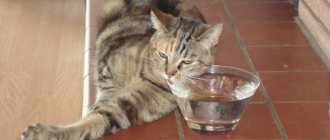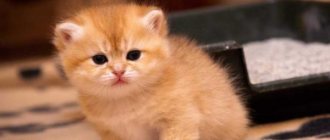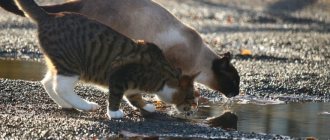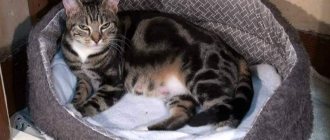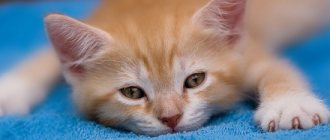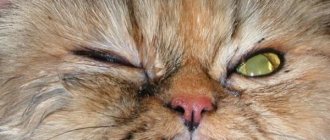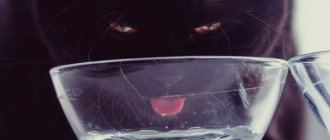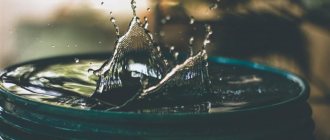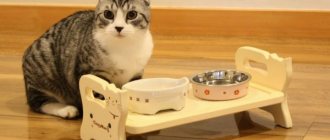Water that gives life
Water is the most important component of the body and maintains the balance of biological fluids. Physiologists say that:
- The body of an adult cat is 67% water;
- almost 60% of the body’s water is inside cells, and 40% is part of extracellular fluids;
- The tissues of a young animal are especially rich in water;
- water makes up 80% of blood and 70% of muscle tissue;
- Bones contain almost 20% water.
Basic functions of water.
Life is impossible without water, since water is part of every cell and determines the biological properties of proteins, nucleic acids and fats.
In addition, water is required for:
- transporting oxygen through liquid tissue (blood) and delivering it to all cells;
- dissolution of nutrients, digestion and absorption of food;
- metabolism in cells;
- removal of waste products from the body;
- maintaining constant body temperature and thermoregulation.
Water standards for cats
Physiological studies have established that:
- The fluid requirement of cats is 20-40 ml per 1 kg of body weight per day;
- in small kittens these figures are 2-3 times higher.
That is why it is recommended that babies under 3 months be given exclusively wet food, in particular canned food, meat baby food, cereal or soaked dry food (read the article on how to properly soak dry food for kittens). Lactating kittens up to 3 weeks of age eat exclusively liquid food: mother's milk or formula milk when bottle-fed.
N.G. Grünbaum gives more specific figures and indicates that the average water rate is:
- for adult cats – 31.5 ml per 1 kg of body weight per day;
- for young animals – 77 ml per 1 kg of body weight.
Other liquids. In addition to drinking water, the following are also taken into account:
- milk and lactic acid products (kefir, sour cream, yogurt, fermented baked milk, unsweetened yogurt, cottage cheese);
- broths and gravies of canned wet rations (meat pieces, pates);
- water contained in meat, fish and offal; raw animal products are quite juicy, but when they are boiled, a certain amount of moisture is also retained;
- liquid used to prepare porridge; the carbohydrate part of the cat’s diet consists of oatmeal and other cereals, which need to be well boiled;
- juice of vegetables and fruits, many cats happily eat the “gifts of gardens and vegetable gardens”, giving particular preference to cucumbers;
- water formed in the body itself; It has been established that the oxidation of 1 g of fat supplied with food produces 1.07 ml of water, 1 g of protein - 0.41 ml of water, 1 g of carbohydrates - 0.55 ml of water.
What determines a cat's need for water?
The constancy of a certain amount of water in a living being is the most important condition for normal life. Every day, a cat loses a certain amount of water through respiration, thermoregulation, and excretion in urine and excrement. That is why the water balance must be restored by consuming liquid from the outside. A cat's need for water depends on:
- Sizes . It has been proven that the smaller the animal’s weight, the higher the need for water per 1 kg of body weight.
- Age . Young growing animals require more fluid compared to adults.
- Level of physical activity . Sedentary apartment animals, spending 18 hours a day in a dormant state, require much less water than their active counterparts who go on adventures on their own.
- Physiological state . Pregnant cats' bodies produce additional fluids, including blood and amniotic fluid, that bathe the kittens in the uterus. A nursing cat also needs to drink more, since the water in her body is transformed into milk, which is given to the babies. Felinologists know that giving milk and sweet tea to a woman in labor stimulates lactation, while females who have undergone a cesarean section may not drink at all, experiencing pain and discomfort after anesthesia.
- Health conditions . Sick cats do not touch water or food, which causes rapid dehydration. If your furry pet has not approached the bowls for 20 hours, this is a serious cause for concern. For small kittens, a critical time period of 12 hours is due to their lower body weight and faster metabolic processes. At the same time, older cats, due to age-related changes and chronic renal failure, may experience severe thirst, but their excretory system is not able to neutralize endotoxins that accumulate in the blood.
- Ambient temperatures . In summer, cats hit more due to the intense work of the thermoregulation system. Due to the lack of sweat glands, baleen-striped animals cannot cool down by sweating, like humans. However, nature has provided compensatory mechanisms for cats: cats suffering from heat begin to lick themselves vigorously, spreading saliva throughout their body and cooling down due to its evaporation. In addition, a small amount of liquid evaporates from the surface of the mucous membranes when a hot cat breathes with its mouth open, and from the paw pads, where the eccrine glands used for marking territory are located.
- Diet. The amount of drinking water consumed also depends on the nature of the diet. Practice shows that an imbalance in water balance can occur when cats are fed exclusively dry food containing a high percentage of protein and minerals with a water deficiency. It is estimated that natural homemade food contains 70-75% water, while in dry food the moisture content does not exceed 10%. To be digestible, the “crackers” must first swell and soak, saturated with water. There is an opinion that for good health, the daily volume of water should be twice the amount of dry food eaten. So, a cat eating 125 g of granules needs to drink 250 ml of water. However, this figure is not canon, since the presence of table salt and flavoring additives in low-quality feed increases thirst.
Why do cats drink from the tap?
There are several versions that explain the habit of purrs drinking not from their dishes, but from plumbing equipment.
- Instincts and genetic memory. Wild cats are predators. The animals do this in order not to pollute the life-giving source with the decomposition products of the killed victims of their hunt. At home, owners most often place their bowls next to food. It is because of genetic memory that furry pets try to drink liquids away from the location of food.
- Some biologists and livestock breeders believe that the reason for the desire is the lower content of pathogenic microscopic organisms in running water. This version concerns animals that are released on the street, where they try not to quench their thirst from puddles, streams and ponds.
- Another version lies in the peculiarities of psychology, as well as in the habits of domesticated predators. Some cats perceive water jets as an imitation of the movement of small rodents. They approach the plumbing not so much to get drunk, but to play with the stream. In this way, the animals train their hunting skills.
- Most breeders of mustachioed meowing friends are inclined to believe that tap water is simply cleaner and tastier than stagnant drinking liquid. In the house, dust and grease residues from food constantly fall onto the water surface, which will lead to its contamination.
- Finally, another version is simple curiosity. Purrs are extremely curious animals, and they can drink both tap liquid and liquid from their own bowl.
Taking a bath
There are plenty of reasons why a cat drinks from a faucet, but does it harm the cat's body?
Dehydration in cats: causes, signs and remedies
Cats, like other animals, endure the lack of water much harder than the lack of food. Thus, zoologists know of cases of mass death of cats in the African savannah during the dry period, when there is no rain, and most natural reservoirs simply dry up.
A well-fed domestic cat can go without food for 2 weeks, but one completely deprived of water dies on the 3rd day.
Why doesn't the cat drink water ? Your pet may suddenly refuse to drink water if it:
- Got sick . Seeing that the water level in the drinking bowl is not decreasing, the owner should take a close look at the animal and its natural functions. Lethargy, fever, discharge from the nose and eyes, diarrhea, and vomiting can be the cause of a dangerous infectious disease. Urolithiasis is accompanied by severe pain, urine is released little by little, acquires an unpleasant odor and contains blood. If your cat tries to drink water but begins to wince and lick painfully, then she may have problems with her teeth, gums, lining of the mouth, throat or esophagus.
- Exposed to stress . Emotional stress can affect the cat’s condition and force him to sit all day in a rescue house or a dark corner. Anything can upset the mustachioed-striped one, from the visit of noisy guests to loud noise in the yard.
- Is in a state of sexual hunting . Individuals experiencing “hormonal storms” may forget about sleep, food and water. In this case, other signs will be obvious, including characteristic postures and vocal accompaniment.
- Dissatisfied with the quality of water or dishes . Cats are extraordinary neat people with a delicate sense of smell, so they are quite capable of refusing to drink from a dirty bowl. Sometimes cats don't like the smell of plastic. In addition, a container that is too deep and narrow can create discomfort for the sensitive whiskers on the face, which rest against hard walls. That is why “cat dishes” need to be thoroughly washed 2-3 times a day, and wide and shallow metal or porcelain bowls should be used for feeding and watering.
How to train a kitten to drink water
Kittens often walk around a bowl of water with disgust. Accustoming an animal to drink water is not difficult, but patience will be helpful:
- The easiest way is active games. When a kitten spends time energetically, it loses some of its moisture. In this case, the bowl of water should be in the most visible place.
- If you completely refuse to drink, you can use a syringe without a needle. Pour small portions of water through the corners of your lips so that the liquid does not flow into your nose.
Some circumstances can play an important role in teaching a kitten to drink:
- Drinks should be kept at some distance from food. The water will stay clean longer. And cats value freshness first of all.
- The bowl itself is also important. Cats being picky is nothing new. Perhaps the baby doesn't like the shape or color. It is advisable to select a bowl according to the size of the animal’s face. When drinking, the mustache should not bend on the edges of the vessel.
What kind of water can you give a kitten?
The most important rule: the water must be clean and fresh. You should not feed your pet from the central water supply. This is due to the possible content of heavy metals and chlorine. It is best to settle tap water and only then offer it to your baby.
Ideally, water for a kitten is passed through a filter or purchased bottled.
Many cats drink exclusively running water; in this case, it is better to equip your home taps with filters.
The freshness of water is a big question if it does not change for a long time. Cats are capricious animals and therefore can flatly refuse stagnant water.
Video: how to teach a kitten to drink water
Water consumption by cats
It is likely that during the course of evolution, cats acquired the ability to get by with relatively small amounts of water. The steppe cat (Felis lybica), the ancestor of European cats, lived in desert areas and was able to concentrate its urine to avoid unnecessary water loss. Modern cats have retained this ability, but it is this ability that makes them predisposed to urolithiasis. A cat can go without food for several weeks, but going without water for several days can pose a serious threat to its life.
Causes of loose stools
Episodes of loose stools that plague a person for one or several days are not a separate disease. This is just one symptom of functional, organic or neural dysfunction. Loose stools that persist for a long time may be accompanied by other clinical manifestations: abdominal pain and cramps, fever, chills, nausea, vomiting, dizziness. It is on the basis of a set of symptoms that one can most accurately determine the cause of loose stools.
The most common factors causing diarrhea in adults are 3:
Loose stools may also indicate pathologies of other organs, such as 4:
The cat is thirsty
Thirst is the feeling that initiates the consumption of water. The corresponding signal comes from the lateral part of the hypothalamus, adjacent to the hunger center. The regulation of water intake is complex and closely related to the variability of blood plasma osmolality, which is controlled by the hormone vasopressin.
The feeling of quenching thirst begins from the moment of stimulation of the oral cavity with water and does not last long. Later, the expansion of the stomach begins to have an effect, and its severity is determined mainly by the frequency of the animal’s intake of water.
Cats are not as sensitive to water loss as dogs and do not become thirsty until such loss exceeds 8% of their body's water supply.
The level of water consumption directly depends on all its losses by the body:
- physiological losses: with urine, feces, exhaled air and milk;
- pathological losses: with diarrhea, vomiting, edema, skin injuries, diabetes, renal failure, etc.
A decrease in blood pressure and volume also provokes thirst due to the activation of hormones of the renin-angiotensin-aldosterone system
Treatment of loose stools: how to get rid of the problem
If frequent loose stools bother you for a long time, then most likely its causes lie in a serious imbalance and require immediate treatment. Unlike one-time diarrhea, systematic diarrhea implies complex treatment, which includes not only eliminating symptoms, but also addressing the underlying causes of the syndrome.
Infectious diarrhea
Treatment depends on the form of infectious diarrhea. In mild cases, home therapy is quite possible, including diet, drinking plenty of fluids and taking adsorbent drugs. A severe form of gastroenteric diarrhea requires hospitalization with a whole range of emergency procedures and restorative therapy, which consists of restoring the lost fluid balance and following a diet.
Functional diarrhea
Treatment of diarrhea resulting from poor diet or malnutrition, as well as disruptions in the gastrointestinal tract, is impossible without proper nutritional correction.
If you adhere to the basic principles of a diet for diarrhea, the problem can be solved much faster, and at the same time will serve as a prevention of possible intestinal dysfunction.
Here are some simple diet rules for diarrhea:
It is important to remember that prolonged, exhausting loose stools are a reason for immediate consultation with a specialist.
The influence of diet composition on the drinking behavior of cats
Animal water consumption largely depends on the composition of the product and its moisture content. Cats that eat canned food practically do not drink water, since their need for liquid is met through food. The same applies to animals that are fed meat or fish.
Dry food contains only 7-8% moisture, and therefore cats that receive it need more water to meet their physiological needs. In addition, dry food was found to increase fecal water loss but reduce urinary water loss. Although cats' water intake varies greatly, their overall water balance is not affected by the moisture content of their diet. The formation of urinary stones is more determined by the mineral composition of urine and its pH than by the moisture content of the diet. The only situation in which the risk of developing urolithiasis increases is when animals are switched from canned food to dry food.
The calorie content of the diet does not have a significant effect on the level of water consumption. An increase in protein content in the diet, on the contrary, is associated with an increase in water consumption. Carbohydrates reduce your water intake due to greater water production during their metabolism. Sodium chloride increases thirst by inducing hypernatremia and thereby increases water intake in cats.
What you can eat after a stroke: basic rules and menu
If you don't eat food as medicine, you will eat medicine as food.
For people who have suffered a stroke, it becomes vitally important to solve two problems: recovery (rehabilitation) and prevention of recurrent cerebrovascular accident. The most important component in their solution is therapeutic nutrition. Despite the different causes of the disease, the diet after ischemic and hemorrhagic stroke is similar.
At the initial stage of recovery, eating regular food naturally is severely limited or completely impossible. Often the patient is paralyzed, has impaired swallowing function, and is given a large volume of medications. To ensure that nutrition during this period is complete, sufficient, properly balanced and easily digestible, special nutritional mixtures are used.
Adipsia and hypodipsia
With hyponatremia, regardless of the cause, animals may stop drinking water. Therefore, adipsia induced by these reasons is actually a compensatory mechanism.
Oral health may cause decreased water intake due to mechanical obstructions or pain when drinking.
Adipsia in some cases occurs as a result of poor water quality. It is always important to remember that a cat will refuse water as long as the need for it is satisfied by consuming wet food!
Polydipsia in cats
Any deviation from the norm for a cat's water consumption must be carefully studied. Her body begins to experience a sharp deficiency of fluid if she consumes less than 100 ml of water/kg of body weight during the day. Any cause of polyuria naturally leads to polydipsia.
Liver failure can also lead to the development of polydipsia due to decreased renin degradation and increased angiotensin activity.
The average level of water consumption by a cat depends on the amount of dry matter contained in the food it eats: a cat needs about 2 ml of water per 1 g of dry matter of food.
Based on the value of blood plasma osmolality, one can judge the nature of polydipsia:
- primary or compensatory.
- if the osmolality of blood plasma exceeds 310 mOsm/l, then polydipsia is classified as primary;
- if this indicator is below 290 mOsm/l, then the cause is considered to be loss of water in the urine.
Excessive salt content in the diet leads to polydipsia and then polyuria.
Polydipsia can be a reaction to stress or the animal exhibiting increased activity as a result of constant anxiety.
About water quality
Until recently, no one was puzzled by the question of the quality of water that a cat consumes. Research and observations in the field of veterinary medicine have led to a disappointing conclusion - bad water leads to the formation of sand and stones in the kidneys and bladder of cats . Urolithiasis is very dangerous, and its development in castrated cats and cats after sterilization, due to the consumption of contaminated water, is almost guaranteed.
A cat should drink water that is not harmful to its health, but how to assess the quality? You probably remember that your parents or grandparents insisted not to drink tap water because it was dirty. Not all people fully understand this phrase. Tap water is clear, visually clean, and quite often even tasty. So why is it dirty? No, this is not a trick question, the answer is obvious. Depending on where you live, tap water may contain salts, heavy metals, pesticides, alkalis and chemicals . Even good tap water always contains chlorine, hydrogen sulfide and salts. The only exceptions are developed countries, where water is purified with safe “bio-additives”.
If the quality of tap water in your city leaves much to be desired, then you should not give it to your pet. Unfortunately, most of the tests carried out on the chemical composition in different regions showed that process water was supplied to residential buildings, that is, unsuitable for drinking and cooking. This situation is observed due to deterioration of water supply systems, soil contamination and the ingress of groundwater into centralized drains.
Many people understand the dangers associated with contaminated water and boil . During the heat treatment process, helminth eggs die in the water, residual chlorine evaporates and sediment precipitates. The so-called scale is solid substances contained in water that are harmful to health.
Another well-known method of water purification is sedimentation . Water should be collected in a clean container, for example a large saucepan, and left in a dark place for a day. It is important that the container is not subject to vibration and is kept cool. After a day, you need to very carefully drain 2/3 of the water into another clean container. If you do everything correctly, the walls of the pan in which you settled the water will be a little slippery, and the remaining liquid will be cloudy.
A more “advanced” option is water purification using filters . In this case, the water is filtered through charcoal sponges, and charcoal is known to absorb toxins. Filtered water can be called clean if the filters themselves are changed regularly. For example, for regions with hard water, most manufacturers recommend changing filters at least once every 1.5–3 months. If the water is very dirty (technical), the filters fail faster.
The next alternative is bottled water . Most manufacturers do not hide their technologies and the composition of the product they sell. No, do not think that this is water extracted from artesian wells. This is the same tap water, passed through several powerful filters. The raw material is “driven” through filters until its chemical characteristics become acceptable, which is why skeptics call bottled water dead. There is only one caveat with purchased water - not all manufacturers change filters as often as they should, that is, the degree of purification of their product does not correspond to the declared one.
We've sorted out the theory, now to the point - what kind of water can a cat have? Most experts express very mixed opinions, or rather, they are afraid to give clear recommendations. There are no clear prohibitions on drinking tap water, but there are very strong recommendations that only purified water is allowed. You can spend hours or even days studying the information and still come to the conclusion that you need to find something in between.
Let's define the main recommendations and prohibitions. Your cat should definitely not be given only purified water. The animal's microflora must be ready for bacterial attack. If a kitten drank only bottled water from birth until adulthood, drinking tap water alone will be enough to cause poisoning or severe stomach upset .
2.TRIO – the most optimal filter for the whole family
Flow-through carbon filter for sink with standard SL 10″ cartridges for soft or hard water
Stages: 3 stages (mechanical, granular carbon or softening, compressed carbon).
Cartridges can be purchased as one set. Cleaning: suspensions, sand, rust, chlorine and its compounds, pesticides, herbicides, organic matter, benzene compounds, improves taste, removes odor. Softens hard water. NSF/ANSI Coal Certifications.
Connection: to a cold water supply through a connector with a ball valve.
Filtration rate: 3 l/min.
Cartridge life: 6-9 months or 6000 l.
Application: Perfect for an apartment or private house
Pros (+):
- Low cost.
- Standard cartridges.
- Possibility of upgrading to membrane cleaning technologies.
- Location of the module under the sink.
- Easy connection and maintenance.
- High leakage protection and long service life.
Price of TRIO filters
Cost of water purification: First year (including the purchase of a filter and replacing the filter 2 times a year) - 0.5 rubles. per liter, in subsequent years about 15 kopecks per liter.
General rules
So, it is absolutely normal for cats to drink little but often. If you are thinking about how to get your cat to drink more water, start by calculating its daily fluid intake and compare this figure with the amount that disappears from the bowl. In hot weather, this observation is more difficult to make because the water evaporates quickly. There is no need to be alarmed if your cat drinks water with its paw, but make sure that:
- The bowl is not too narrow - the whiskers should not curl when the cat drinks.
- The bowl is too deep - it is better to use wide and shallow bowls.
- The cat does not experience pain when bending its neck.
- The cat's teeth are healthy.
- The water is not too cold.
- The water is clean.
At any time of the year, especially in winter and summer, the cat should have unhindered access to water. The volume of the drinking bowl should exceed the animal's daily fluid intake by at least 50%. The bowl should be washed every day, 2-3 times a day in summer. These conditions are especially relevant for animals kept on dry food , since the granules swell after ingestion, and provoke extreme thirst.
If you are going on a trip, stock up on clean water to give your cat water on the road. If this moment is missed, do not even think about giving your cat water collected from a puddle or pond. Most likely, such a decision will lead to dysbiosis and infection with worms. It is worth understanding that water from puddles and standing reservoirs may contain eggs of very dangerous helminths.
Important! Do not allow your cat to drink water from the aquarium or toilet. In the first case, there is a high chance of a bacterial outbreak (the microflora of the aquarium is very specific), in the second, comments are unnecessary.
Reverse osmosis water filters
Flow-through filter under the sink with standard SL 10″ cartridges for complete water purification of 99.8% of all known contaminants
Stages: 5 stages (mechanical, granular carbon, compressed carbon, reverse osmosis membrane, carbon block). Cartridges can be purchased as one set.
Cleaning: 99.9% contaminants. Complete desalination and disinfection of water. NSF/ANSI Coal Certifications.
Connection: to a cold water supply through a connector with a ball valve.
Filtration speed: Purified water is stored in a 12 liter container. Thus, after draining about 9 liters of clean water, the flow rate will decrease to 150 ml per minute.
Cartridge life: 6 months or 6000 liters, membrane - 1 year or 11,000 liters.
Application: Perfect for apartments, cottages with well water supply.
Pros (+):
- You can drink water without boiling it.
- Complete purification, softening and disinfection of water.
- Standard first stage cartridges SL 10″.
- Easy connection and maintenance.
- The pump provides the required pressure.
- High leakage protection and long service life.
Price of reverse osmosis filters
Cost of water purification: First year (including the purchase of a filter and replacing the filter 2 times a year) - 1.5 rubles. per liter, in subsequent years about 40 kopecks per liter.
More filters for washing here
Published: 11/08/2019
Water consumption rate
Let's figure out how to calculate the amount of water a cat should drink per day? The daily norm is calculated in several ways, and its fluctuations depend on the weight of the animal and the type of food it eats. You need to understand that the indicator obtained during the calculation process is not the absolute truth for each individual animal. The resulting volume of liquid is a guideline, that is, if the cat begins to drink more or less, it needs to be shown to a doctor or at least carefully monitored.
According to generally accepted rules, the daily water intake is calculated based on weight, namely: 20–40 ml per 1 kg of weight . Some veterinary reference books indicate slightly different information: the rate of water consumption is 50 ml per 1 kg of weight per day. Kittens drink a little less, adult cats drink more.
Some recommendations apply to animals that eat only dry food. The daily water intake should be twice the weight of the food eaten. That is, if a cat eats 150 grams. granules, she should drink at least 300 ml of water. This indicator is not justified from a practical point of view if the cat is kept on high-quality food that does not contain salt.
When calculating your daily water consumption, you need to take into account one more nuance, namely the type of food. We talked about dry food above, but if a cat eats natural food, the amount of water it drinks may decrease if the cat receives milk, broths, canned food with gravy and other wet food.
Factors influencing water consumption
Having calculated the daily water intake for a cat and discovered that the pet does not drink it (or drinks more), you need to take into account several more factors. The fact is that a cat drinks according to its needs, no more and no less. At the same time, there are a number of ailments that increase thirst or cause the cat to refuse to drink .
Unless sick, your cat may consume more water for the following reasons:
- Hot weather - the cat becomes thirsty as natural fluid loss increases.
- Dry air - thirst increases as the mucous membranes quickly dry out.
- Pregnancy - the mother's body constantly produces additional blood and amniotic fluid.
- Rehabilitation after childbirth and lactation - the cat should drink a lot more water, since excessive fluid consumption leads to dehydration.
A sharp decrease in water consumption or temporary refusal of it may be associated with:
- Rehabilitation after surgery - after recovering from anesthesia, the cat may refuse water. In this case, the mouth must be forcibly wetted, but there is no need to fill it with water. After long operations, it is sometimes necessary to put drops in the eyes and nose (to moisturize).
- Dampness – the cat loses less moisture.
Important! Refusal of water for 20 hours in an adult cat and 12 hours in kittens is not normal; the cat needs help and it is better to contact a veterinarian immediately!
